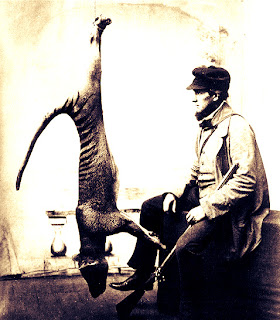We destroy what we don’t understand
Every September 7 in Australia is National Threatened Species Day. On this date, in 1936, the last Thylacine or Tasmanian Tiger, “Benjamin”, died in a zoo at Hobart, Tasmania.
Looking like a wild dog, the Thylacine was the largest marsupial (pouched mammal) before it died out. This distinction is now held by the Tasmanian Devil.
Australia and Tasmania are such that pouched mammals apparently took over the niches occupied by other, more familiar animals elsewhere in the world.
The Thylacine’s scientific name is Thylacinus cynocephalus “dog-headed pouch one.” They were shy and beautiful creatures, brown with blackish brown ‘tiger’ stripes down the lower back. Their tails were stiff, flaring as it neared the animal’s back. They had the widest jaw gape of any mammal ever seen. Because both sexes had pouches covering the genital areas, it was hard to determine, just by watching, which was male and female.
Although they already were extinct from mainland Australia for about 3000 years, there were still many Thylacines (also called Tasmanian Wolves) in Tasmania when European settlers arrived in the island in the early 1800s.
As the settlers established farms for their poultry, sheep, and cattle, they perceived the Thylacine to be a pest—the Tasmanian version of the wolf. And, like the wolf which was exterminated in England and Scotland, they proceeded to do just that to the Thylacine—trapping, snaring, poisoning and shooting them systematically.
Bounties were placed on their heads; their killers (called “tigermen”) celebrated as heroes. A favorite trick of trappers was getting families—getting the mother first, and waiting for the cubs to look for her.
Even if they were the apex carnivores in their domain, Thylacines stood no chance against the white man. Unlike the familiar pouched mammal, the opossum, which plays dead (actually paralyzed from shock) on meeting people, many Thylacines apparently died just from the shock of being captured.
By the early 20th century, the Tasmanian tigers were a rare curiosity. Their capture then focused on serving the zoo, museum and sideshow trade—accelerating their demise even further.
By the time people realized the damage to livestock wasn’t done by Thylacines, it was already too late; the Thylacines were already dying out. “Benjamin” was the last recorded Thylacine alive—a part of a captured family of a mother and three cubs—although, because of their anatomy we don’t really know for sure if Benjamin was really male. They, however, outlived the full-blooded Tasmanian Aborigines—also victims of the European settlers’ greed and fear—by a few decades.
Though there are reported sightings from time to time, what we definitely have left are bones, stuffed skins, and black and white pictures and film clips of the Tasmanian Tiger’s last days. There is also an online museum dedicated to the Thylacine. Let every September 7 remind us to be kind to all creatures.
You have read this article with the title Thylacine. You can bookmark this page URL http://kncatchat.blogspot.com/2012/07/thylacine.html. Thanks!















No comment for "Thylacine"
Post a Comment